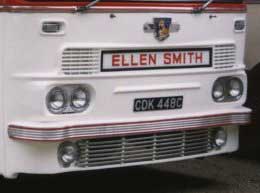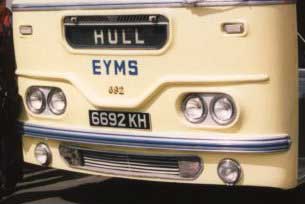It is hard to say what has caused the Harrington Cavalier to become one of the most admired and best remembered British coach designs. It was in production for six years and was still highly regarded when Harrington decided to cease coachbuilding. Perhaps it was that the end came while it was still on top and it never suffered a slow declining fate such as happened to Burlingham's much revised Seagull design. In recent times of course it has enjoyed recognition by virtue of Exclusive First Edition's model range.
Another page of this web site details the Harrington Crusader and certain detail elements of that design that found their way into the Cavalier. Many of these details combined to give the Cavalier a quality feel that was so important to the operators of under floor engine chassis (the expensive end of the market).
Particularly important were the pressed window pans with specially produced rubber moulding and a return to joint strapping which concealed the fastenings for the panels. In fact the method used by Harrington for this dated back to pre-war. Unlike the Crusader, which was attempting to keep weight down, the Cavalier frame had a full inner lining panel of aluminium sheet between floor and window level, cold riveted to a new, stronger version of the familiar top hat pillar section. The outer panels were also riveted to the uprights but the joins concealed as mentioned above. So strong was this construction that even today driving a Cavalier is marked by the lack of vibration rattles drivers came to expect in coaches built during the seventies. Despite the fact that the Crusader made its first appearance only a year ahead of the Cavalier, it failed to be of really modern appearance due to the use of old style flat windscreens set into a metal frame. Fortunately, the Cavalier only incorporated the new design features of the Crusader and and had tall curved rubber mounted screens from the start. The rubber used was thicker than previously seen and the same section would come to be used by Plaxton and Duple in the future. In fact the overall appearance of the whole front panel was right from the start. It abandoned the use of a large dummy radiator grille which had been used on previous designs regardless of the fact that the radiator was actually somewhere behind the set back front axle. Sufficient air was allowed underneath the coach by a wide grill below the bumper level which was much less obtrusive. Remarkably the stepped waist rail also made a re-appearance, in almost exactly the same place as the first Wayfarers some 10 years earlier.
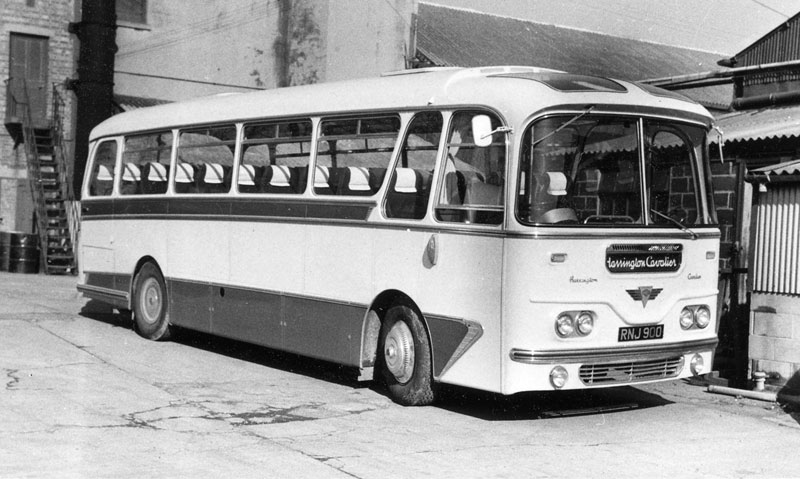
The first Cavalier was body 2200, registered in February 1960 as RNJ 900. It is photographed here at Sackville Works. The Wayfarer 4 and Crusader both had changes made after just a few bodies had been produced but RNJ 900 appears to be no different from the many Cavaliers that followed afterwards. It eventually came to rest with an operator in Bodmin, and although its significance was not unknown, it failed to make it into preservation.
The Cavalier was an instant success. Significant advance orders were taken on the strength of drawings alone. As early as August 1959 firm contracts for ten coaches each were placed by Timpsons and Northern General. There were smaller orders of four with East Yorkshire and three to South Wales Transport. Although the orders were in, Cavalier production did not get underway immediately. For the remainder of 1959 the factory was kept busy with significant bulk orders for the Crusader and bus exports to Barbados. Once started though, production soon gathered pace. Although the Cavalier was supplied in ones or twos to independents, an order of up to ten to a BET company was much more likely. The AEC Reliance was the most popular chassis. Out of the first forty Cavaliers, only four were Leyland - The Tiger Cub, even though the Leyland Leopard had been introduced in 1959. Finally, in February 1961 an order went to Northern General who, obviously satisfied with their first batch returned for another ten bodies but this time on on Leopard chassis.
Some of the Timpsons coaches were specially equipped for Continental tours. in which case the seating was reduced from the standard 41 to 37, with the provision of Chapman reclining seats. Taking account of the continental practice of driving on the "wrong" side of the road, there was also an automatic fold out step linked to the emergency door, thus allowing passengers on to disembark away from the traffic passing by. This option was rarely taken up by other operators and quite frankly it does look suitable for frequent use only by passengers of a confident nature.
Another highly attractive feature found on all Cavaliers - later to be extended to other models - was the lift up side flaps. This cantilever system was patented by Harrington. It's prime function was to provide locker covers that were not hinged at the top and therefore could be opened using less space. This was useful
in crowded coach parks with closely packed vehicles. The locker cover stayed in position by pulling the top slightly out when in the fully open position. All that was required to close it was to take the weight off and push the top inwards.
Early production Cavaliers had two opening boot doors with conventional hinges, but later models used another version of the cantilever idea. The single door was not heavy, being made of fibreglass, but when open it employed only one of the two latches normally used to keep it shut, which on older vehicles could be difficult to engage. The idea was not universally popular (there was rather a feeling that leaning into the boot was like leaning across a guillotine) and a few operators continued to specify ordinary boot doors.
Following a change to the construction regulations, a Cavalier built to the newly allowable length of 36 feet by 8 feet 2.5 inches arrived in March 1962. This allowed an increase from 41 to 51 passengers. In common with many other coachbuilder's designs to the new length, the Cavalier 36 tends to look "busy" from the side due to the number of windows.
The "short option" Cavalier was extended to 31feet 5 inches long and this change was accommodated entirely by varying the window length at the stepped waist rail. A few of the old length of 30 feet were still built on request after this date. To complicate matters and for reasons unknown, the shorter Cavaliers continued to be made to a width of 8 feet. The 36 foot version had gained an almost imperceptible couple of inches either side of the windscreen pillars at the front. At the rear, to allow use of the existing glass size, the divider between the rear windows was made wider (later, all Grenadiers would have the wide divider). Although it is quite possible that the Cavalier could have been ordered short and wide, no evidence has yet been found that one was actually produced. (A challenge there for you).
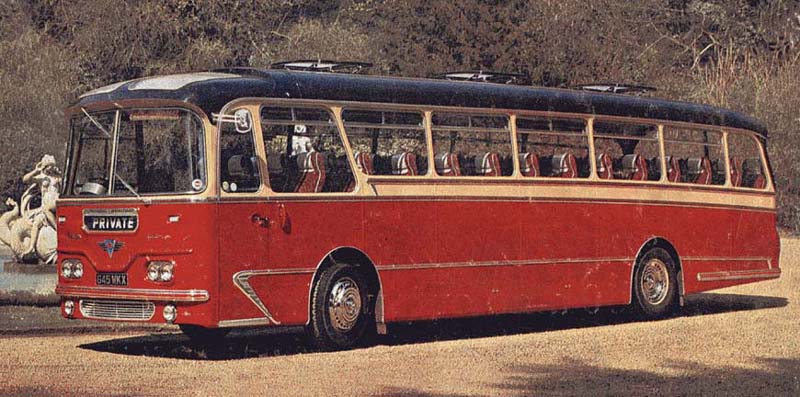
A Cavalier 36 is pictured above. It is body 2610, registered 645 WKX for Keith of Aylesbury. The photograph is from a Harrington colour advertisement. It has one additional side window, but note also how the feature window just after the passenger door has been extended compared with that on RNJ 900
During the 1950s, owing to the way that Harrington brought out new designs even while orders for the previous style had yet to be built, they gave the impression that two styles were always available to suit a particular chassis. And in effect they were, because Harrington would continue to make the older style until no more orders were forthcoming. It was a sort of rolling change. During the first two years of the Cavalier, the Wayfarer 4 was still available although built in very small numbers. The Grenadier was made available towards the end of 1962. The only change from the previous precedent was that despite the similarity to the Grenadier and the later availability of Legionnaire and Crusader as well, orders for the Cavalier remained strong right up until mid 1965, the last full year of factory production. It is even possible that Cavalier production only stopped to clear the decks for the next design - unfortunately still born.
The introduction of the Grenadier in 1962 followed close on the recent involvement of the Rootes family in Harrington's affairs, but it was almost certainly planned before this and can probably be attributed to Clifford Harrington's guiding hand before he left the company. Designs after the Grenadier show a distinct sea change with regard to economy of build. The Grenadier really was slightly more than a "face lifted" Cavalier, but of course doomed to be often mistaken and called by the same name as the older design. Furthermore (left) the chap in the slightly dodgy hat somehow lacks the aplomb of the gay Cavalier.
From the start the Grenadier was constructed to take advantage of a change in legislation that permitted construction to a maximum width of 8 feet 2.5 inches. The official debut was at the October 1962 Earls Court Commercial Motor Show, with two 36 models. Whether Harrington expected to gradually phase out the Cavalier after this is unknown. In fact, orders for the Cavalier were so strong that it was a nearly a year before Grenadiers were delivered in any quantity. When the Grenadier appeared to the maximum allowable dimensions, Harrington took the opportunity to increase the luxury of the seats. Given the small size increase, this may seem hardly worthwhile, but some operators have sometimes fitted Grenadier seats into Cavaliers and the reduction in centre gangway width is very obvious.
The Grenadier had the same overall style as the Cavalier but the differences though subtle were significant. An important point for the passengers was a change to the ventilation arrangements. This was made possible by incorporating air intakes into the peak above the windscreen and using Smiths "Jet-Vent" outlets above each seat. This could also be adapted to demist the side windows as well if required. It was now possible to discontinue sliding top vent windows and instead have large (and neat) fixed glazing to the coach sides. Naturally this was not universally popular and sliding vents were made available as an option, but at increased cost despite the deletion of the Smiths system. This was because the windows fitted with sliders were actually Cavalier items and extra frames were required. Another complication with the Grenadier was that as a result of the longer side windows the distance between the roof frames was slightly longer than that of the Cavalier and using the same glass cant panel windows (which were quite popular) was not practical. Therefore the few Grenadiers that did have the roof window option, had the windows on each side made in Perspex.
Although the Crusader IV and Legionnaire designs post dated the Grenadier it was the latter which was the only style of full size coach still in production when the factory closed. The last one was body number 3218 for Greenslades of Exeter. It was one of a batch of four built to the shorter 3110 specification. Despite the significance of this vehicle it is not thought that there was any particular feature that marked it as the last Harrington.
Photo © Cliff Essex
By 1976 the last Harrington coach, FFJ 13D was wearing the yellow & white livery of Nightingales of Budleigh Salterton. Despite efforts to save it for preservation, it changed hands suddenly and passed through dealers to become a car transporter in the Suffolk area.
The Things They Say ...
Blackpool Coach rally March 1968 (two years after Harrington ceased production)
"Perhaps the writer's favourite vehicle though was KTC 330C the Harrington bodied Reliance of Warburton Brothers (Bury) Ltd. with which the driver Ernie Salisbury had won awards in both 1965 and 1966, and which is perhaps best remembered for the argument it had with the rocks during the former year. The only word to describe this machine was immaculate. Its ivory and black paintwork, ideally suited to Harrington Cavalier design absolutely shone, and it was a tribute to Warburtons and driver Ernie Salisbury who is claimed to keep it in this state even through the height of a busy season. It well deserved the concours class award which it received".
Terry Shaw, writing in "Buses" June 1968 about Warburton's Grenadier entry at the 8th National Coach rally at Blackpool.
How to tell the difference between a Cavalier & Grenadier
The first thing to remember is that there is an exception to every rule.
But that does not mean there are no rules.

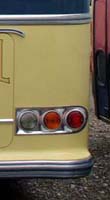
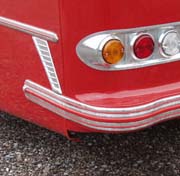
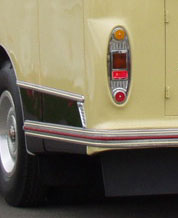
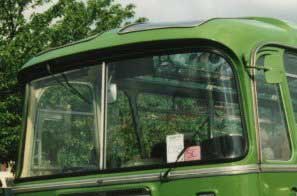 intakes for the Smiths forced ventilation system. The windows
in the dom
intakes for the Smiths forced ventilation system. The windows
in the dom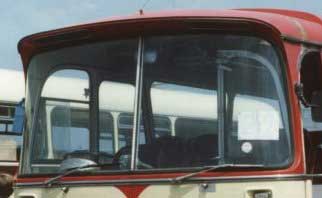 e of the Cavalier were an option usually taken up together with
the fitting of windows in the roof cant panels, but I do not believe any
Grenadier had windows in the front roof panel and indeed, windows in the
rest of the roof were comparatively rare. Note also that the rain gutter
on the Grenadier does not follow the curve of the door. This was usually
the case but there were some exceptions. Both were available with domes
incorporating a destination display though this was first developed for the Cavalier and the same version was used on the Grenadier - meaning Cavalier screens had to be used!
e of the Cavalier were an option usually taken up together with
the fitting of windows in the roof cant panels, but I do not believe any
Grenadier had windows in the front roof panel and indeed, windows in the
rest of the roof were comparatively rare. Note also that the rain gutter
on the Grenadier does not follow the curve of the door. This was usually
the case but there were some exceptions. Both were available with domes
incorporating a destination display though this was first developed for the Cavalier and the same version was used on the Grenadier - meaning Cavalier screens had to be used! 